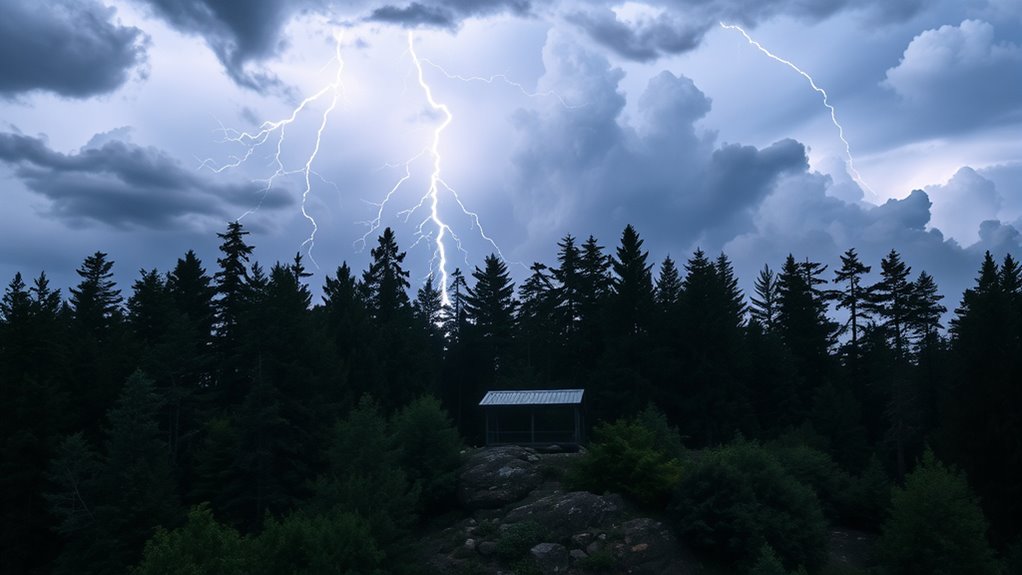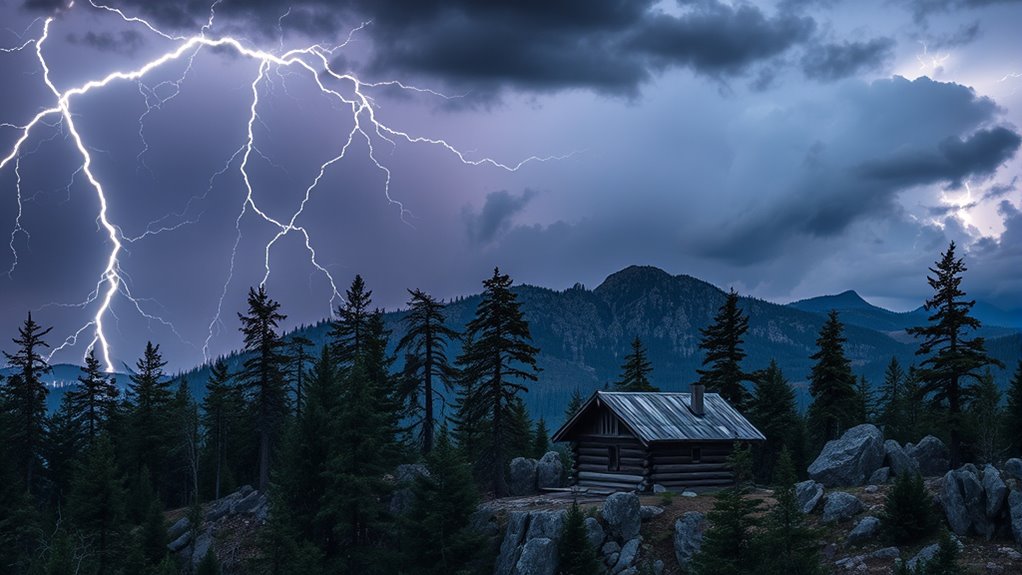If you’re above the treeline during a thunderstorm, your safest choice is to seek enclosed structures like buildings or vehicles with metal roofs, which act as Faraday cages. Avoid open spaces, lone trees, water, or tall objects that attract lightning. Move swiftly to a sturdy shelter as soon as you hear thunder or see signs of a storm. Continuing now will help you understand more key safety steps to protect yourself effectively.
Key Takeaways
- Avoid sheltering under lone or tall trees; they attract lightning and increase injury risk.
- Seek enclosed structures or vehicles with metal roofs for maximum lightning safety.
- If caught above treeline, crouch low with feet together, minimizing ground contact and exposure.
- Do not wait for thunder or lightning; move promptly to the nearest safe shelter when storms approach.
- Stay informed with weather updates and plan routes to steer clear of exposed areas during storms.

Lightning protocols are essential procedures designed to protect people and property during thunderstorms. When you’re in an area exposed to the open sky, especially above the treeline, understanding how to respond to lightning threats can mean the difference between safety and danger. Your first priority should be storm safety, which hinges on quick judgment and knowing where to seek shelter. Selecting the right shelter during a storm requires careful attention to your surroundings and swift action.
Lightning safety begins with quick judgment and choosing proper shelter during thunderstorms.
When a thunderstorm is approaching, your immediate instinct might be to keep moving or seek cover behind a tree, but that can put you at greater risk. Trees and other tall objects are often lightning targets because they provide a direct path to the ground. Instead, focus on shelter selection that minimizes your risk of being struck. The best option is to find a substantial, enclosed structure, such as a building or a vehicle with a metal roof and sides. These act as Faraday cages, dispersing electrical energy and protecting anyone inside from lightning strikes. If you’re on a trail or in an outdoor setting, look for a designated shelter or a sturdy building nearby—do not take shelter under a lone tree or in an open space, as these are prime lightning strike zones.
If no proper shelter is available, and you’re caught in the open above the treeline, your storm safety strategy should include avoiding isolated tall objects, water bodies, and open fields. Crouch down low with your feet close together, minimizing your contact with the ground, and keep your head below the level of the surrounding terrain if possible. This reduces the chance of a direct strike and minimizes ground current exposure. Remember, staying in the open is perilous, so your goal is to reach the closest suitable shelter as quickly as possible.
Storm safety also involves being aware of weather updates and acting promptly. Don’t wait until lightning is visible or thunder is loud to seek cover. The sound of thunder can travel great distances, so if you hear it, consider the storm nearby. Always err on the side of caution and prioritize shelter selection that offers maximum protection. Keep an eye on the sky, listen for weather alerts, and plan your route to avoid venturing into exposed areas during storm season. Being prepared and knowing how to choose safe shelter can profoundly reduce your risk of lightning injury or worse. Additionally, understanding the importance of high contrast ratio in visual safety can help you better assess your environment and make quicker decisions during emergencies.
Frequently Asked Questions
What Are the Best Materials for Lightning-Resistant Shelter Construction?
When choosing materials for lightning-resistant shelters, you want to focus on conductive materials like metal or specially designed lightning protection systems. Incorporate grounding techniques to safely direct lightning away from the shelter, and consider shelter height considerations to minimize risk. Using grounded metal frameworks and ensuring the shelter isn’t excessively tall can markedly enhance safety, reducing the chance of lightning strikes and protecting everyone inside.
How Can Hikers Identify Safe Shelter Options in Lightning-Prone Areas?
Finding a safe shelter in lightning-prone areas is like spotting a beacon in a storm. You should look for trail markers indicating shelters nearby, and check if they’re easily accessible. Avoid open fields and lone trees, and seek sturdy structures or caves. Always assess shelter accessibility quickly, so you can reach safety promptly. Your goal is to stay protected and avoid exposed areas until the lightning subsides.
Are There Emergency Devices to Detect Nearby Lightning Strikes?
You wonder if emergency devices can detect nearby lightning strikes. Yes, lightning detection tools and emergency alarms are available to alert you quickly. These devices use sensors to detect lightning activity within a certain radius, helping you stay safe. Carrying personal lightning detectors or installing alert systems in your area can give you vital warnings, so you have more time to find safe shelter and avoid dangerous strikes.
What Role Do Weather Apps Play in Lightning Safety Planning?
Like a modern oracle, weather apps guide your lightning safety planning by providing storm prediction updates. You rely on their app accuracy to help you decide when to seek shelter or avoid treetops. These tools offer real-time alerts, giving you critical information to stay safe during thunderstorms. By integrating weather apps into your safety routine, you become proactive, reducing risks and making smarter decisions during lightning threats.
How Often Should Shelters Be Inspected for Lightning Safety Compliance?
You should inspect shelters regularly, ideally every six months, to guarantee lightning safety compliance. Check that electrical grounding systems are intact and functioning properly, as well as the shelter’s elevation to prevent lightning strikes. Look for any corrosion or damage that could compromise safety. Regular inspections help you identify potential hazards early, ensuring your shelter remains a reliable refuge during thunderstorms and adheres to safety standards.
Conclusion
Remember, lightning is a wild beast lurking in the sky, and your best bet is to find safe shelter before it strikes. By following proper protocols above the treeline, you become a skilled sailor steering clear of stormy waters. Stay low, avoid isolated trees, and seek sturdy shelter quickly. Your safety depends on acting swiftly—think of yourself as a lightning hunter, not a target. Stay vigilant, stay safe, and keep the storm’s fury at bay.











